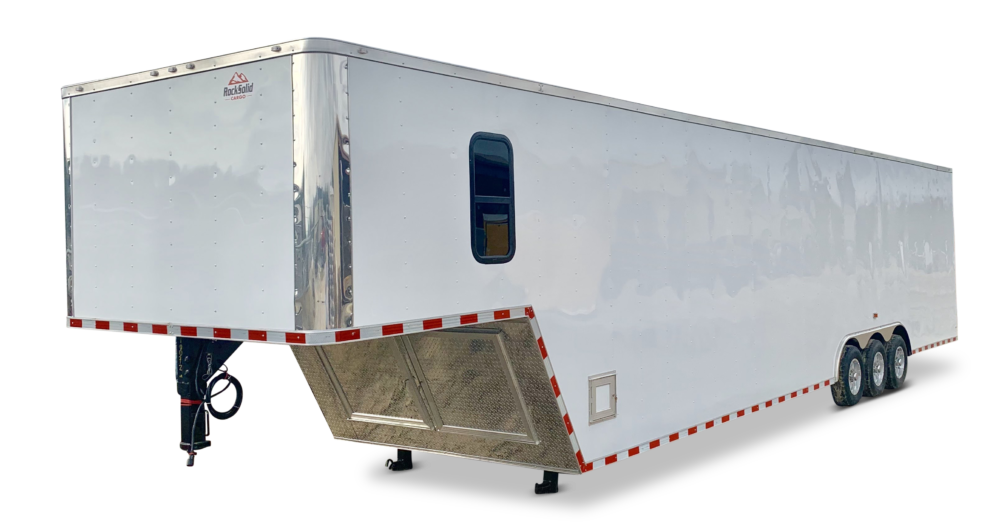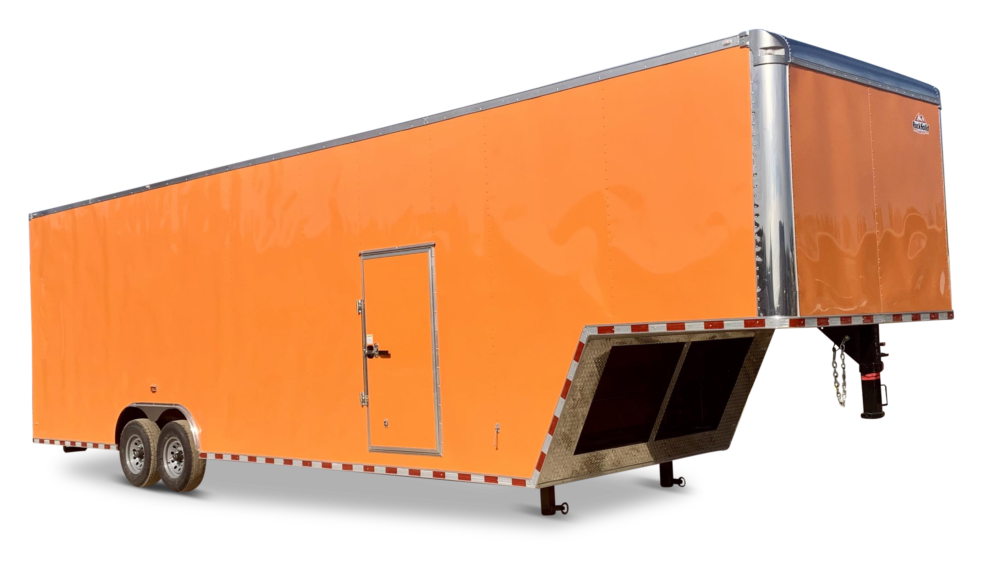Gooseneck trailers are undeniably the beasts of the enclosed trailer scene. These behemoths are for the biggest loads, whatever heavy cargo needs to get transported from A to B safely and securely. Our gooseneck trailers offer a lot of advantages for the heavy load haulers but there’s some important considerations to remember as you tackle gooseneck towing for the first time.
In today’s spotlight series, we’ll cover everything you need to know to tow a gooseneck on the open road.

What Makes a Gooseneck Trailer Different from Other Enclosed Trailers
Most trailers are attached to a tow vehicle’s receiver hitch or via a bumper hitch. A gooseneck is different from traditional enclosed trailers both in its namesake shape and because of the gooseneck hitch attachment within the vehicle’s bed. This allows a gooseneck trailer to be attached to the tow vehicle over the rear axle which is different from a hitch receiver, located at the rear of the vehicle. This provides far greater stability for the tow operation and in turn allows for larger loads to be safely carried. Also, because of the closer proximity of the trailer to the tow vehicle, a gooseneck trailer will typically have a tighter turn radius over other enclosed trailers.
Before You Drive With Your Gooseneck Trailer
With a big trailer, comes big responsibility to make sure you stay safe on the road. Checking over just a few simple details before you ever put your vehicle in drive can easily mean a safe trip from A to B over having an incident on the road.
Know Your Numbers
Since goosenecks are rated for really heavy loads, first things first is to make sure your tow vehicle has the towing capacity to handle the load. There is no “best truck for pulling a gooseneck trailer” but your tow vehicle should obviously have the capability to safely tow the combined weight of the vehicle and the trailer. But how do you go about finding these figures? Manufacturers will specify the exact numbers for each of the four weight limits every gooseneck trailer driver should know:
- Gross Vehicle Weight Rating (GVWR): this is the max weight of your vehicle’s empty weight and all of the passengers, cargo, fuel, etc. that the vehicle can safely carry.
- Gross Combined Weight Rating (GCWR): this is the maximum weight that the fully-loaded tow vehicle and trailer can be. It can also just be referred to as GVW and refers to the weight of the empty gooseneck plus the cargo inside. For example, a Gooseneck 5200 Triple Axle that is 38’ has an empty weight of 6,820 pounds and a max cargo weight of 8,780 pounds for a total GVW of 15,600 pounds.
- Payload/Cargo Capacity: this is the maximum weight of cargo that your enclosed cargo trailer can carry.
- Towing Capacity: this is the maximum weight that your tow vehicle can safely tow.
If you have any questions on these, don’t risk it. Check out our trailer measurements page or talk to one of our trailer experts to get you in the know on safe towing weights before hitting the road.

Run Over Your Gooseneck Trailer Checklist
Doing a quick once over on your gooseneck trailer and tow vehicle before getting on the road can save a lot of time and aggravation over having a component fail mid-drive. Here’s a few things to check over:
- Tire Pressure: make sure all the tires on the trailer and on the tow vehicle fall in line with the manufacturers’ specifications. Overinflated and underinflated tires can cause uneven tread wear, a reduction in gas mileage, increased engine wear, and can even result in a blowout. While looking over your trailer’s tires, go ahead and make sure lugs are tight. These can become looser over time and with a lot of strain from towing. Bearings will also require grease from time to time. If you happen to jackknife your trailer, such as when reversing, you can put a lot of pressure on the sides of the tire which can also add to premature wear.
- Secure Connection: always, always make sure you have the correct ball size and the connection is secure before departure. While gooseneck trailers like other enclosed trailers have safety chains attached (make sure this is true prior to departure), you don’t want to put these to the test and can still end up damaging your trailer and vehicle if a disconnect occurs. We’ll cover how to hitch a gooseneck trailer a little later.
- Make Sure all Lights are Working: check your connectors for wear and tear and test out the connection. Make sure your signals, brake lights and running lights are all functioning both for safety and because it’s illegal to drive without working lights.
- Secure Cargo Inside the Trailer: any kind of big and/or heavy cargo should be tied and secured in place before towing. Within Renown’s Goosenecks, you’ll have at least four (4) 5,000-lb rated D-rings. The straps should also be rated highly enough for the job you’re asking them to do. If you have a sudden swerve or braking event, the cargo could shift making the trailer a lot more difficult to handle. Also, always do your best to balance the load over the axles.
This list is not entirely exhaustive and can vary depending on your tow vehicle, the gooseneck, and the cargo being hauled. Our trailer experts can help you find the perfect gooseneck, based on your needs. Talk to a trailer specialist now.
How to Hook Up a Gooseneck Trailer
- Before you back your truck up, raise the coupler above the ball/truck bed.
- We use a 2 5/16” adjustable coupler.
- Back up the truck and align the coupler above the ball.
- Make sure the coupler is unlatched and in the “open” position.
- Lower the gooseneck trailer onto the ball.
- Secure jack handle.
- Raise jack feet by releasing the pins.
- Climb into the truck bed to connect the breakaway cable on the hitch system.
- Connect safety chains to u-bolt or d-rings on the gooseneck hitch.
- Close the coupler and latch the safety pin.
- Find your receptacle and connect to your 7-way plug.
- Perform “preflight” checklist outlined above and, once complete, drive safe!
Bottom line, when you’re looking at how to hitch a gooseneck trailer, make sure you absolutely know the trailer is firmly attached to the gooseneck hitch attachment. If you need any help, don’t hesitate to ask and our helpful staff will walk you through the whole process until you feel comfortable doing it yourself.

Gooseneck Trailer Hauling on the Open Road
Now that your trailer is all ready for the open road, how do you go about driving with a gooseneck trailer? The same principles for safe towing goes into this larger package, you just need to remember it is indeed larger so take extra precautions. Staples for towing like adequate sight lines in your mirrors, avoiding excessive speeds, and giving other vehicles a wide berth when passing and changing lanes should all be incorporated into your overall safe driving behavior.
Some other things to remember when towing a gooseneck trailer include:
- Try and speed up and slow down gradually. This will make your trailer components like the brakes and tires last longer but will also help keep the cargo secure.
- Be aware of the speed limit for large trailers in your state of travel. Some states have lower limits for vehicles with trailers.
- Give yourself more room to stop. With a heavy trailer that’s fully loaded, it will take more distance to slow a trailer traveling at speed.
- If going down a hill, try to downshift. This helps reduce your speed in a less stressful manner to the tow vehicle’s and gooseneck’s braking systems.
One consideration you may not have thought of is the fairly tight turn radius of a gooseneck. While helpful in maneuvering, you may not be used to the gooseneck’s tight turn radius. With a gooseneck’s shorter distance from the trailer to the tow vehicle, the turn is all the tighter and can cause your trailer to go onto the curb if the turn is too tight so always swing it wide but be aware of vehicle’s around you and any other obstacles or hindrances near the corner.
Ready to Check out Renown’s Gooseneck Trailer Line?
If you are ready for a totally new trailer buying experience, our team stands ready to exceed your expectations. No pushy sales people, no high pressure sales tactics, just trailer pros working with integrity towards getting you in the trailer that meets your needs. If we can’t do that, we won’t try and sell you something that isn’t right and would gladly send you to a competitor that better met your needs. Service that’s focused on being kind, the kind of service we’d want someone to give our family, is what sets apart the experience.
Check out our gooseneck trailers online and if you spot one you like, you can complete the entire process online and have it shipped right to your door. If you’d rather meet your new trailer in person, we’d love to see you at our dealership location.

What is the law for using your safety chains? My friend never uses hers and I always use mine. She was told it is more dangerous to use them. Do you have any literature? She hauls a 32 foot horse trailer, 2 horse, I haul a 40 ft trailer 4 horse. I am not finding much information on safety chains. Both trailers are goosenecks. Thank you for your help.
Dear Representative,
I have a half ton Ford F-150 Crew Cab 4 door truck. What is the largest Gooseneck trailer do you recommend I pull with a half ton vehicle. I am shopping around for a used trailer and it seems to appear that I am coming across better deals with individuals who have gooseneck trailers for Sale opposed to used bumper Cargo trailers. Would you recommend pulling a 16′ to 18′ gooseneck trailer with a half ton truck? Your expertise is very much appreciated because I am not sure. I have never pulled a gooseneck trailer.
Good afternoon, the answer is really more in the weight of the cargo you are carrying and the ability of the truck. You would need to check the towing capacity of the specific truck/motor/gear ratios to get an accurate weight to do it safely. Then a reference to our weight chart on the website for goosenecks.
I didn’t know much about the things mentioned in this article, so thank you for providing this information. On Friday, a gooseneck trailer will come to me, and there is not enough knowledge of how to operate it.